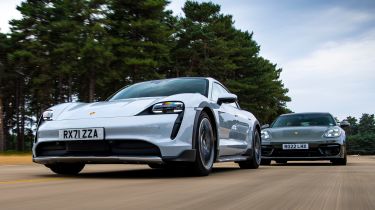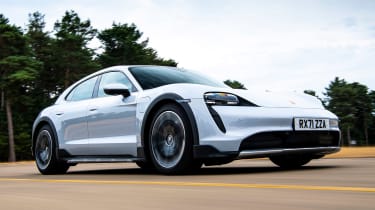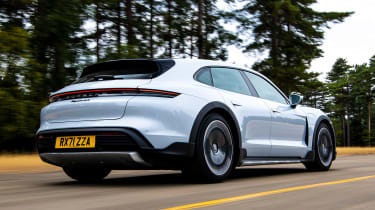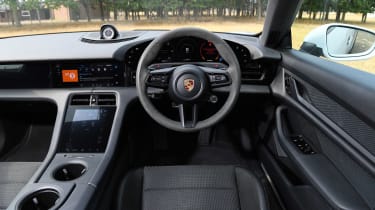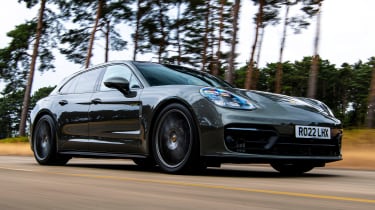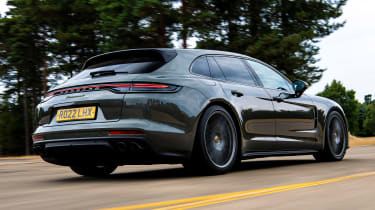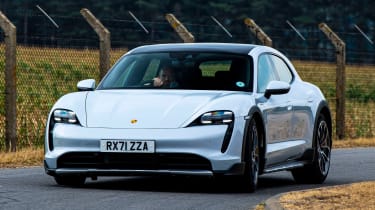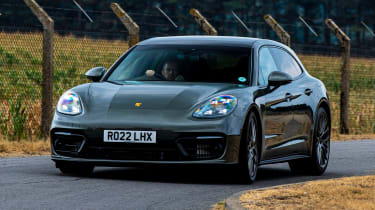Porsche Taycan vs Porsche Panamera: 2022 twin-test review
Two Porsches, two estates, two grand tourers, but two very different powertrains. Is the Taycan or Panamera number one?
When you think of a big, premium performance car, your first thought is probably of something large with two doors and four seats. Something that blends style with performance and comfort – and most probably a hefty price tag.
Like many different niches in the new-car market, however, the boundaries between segments is being continually blurred and ever-more broad, resulting in cars that have greater depth.
Porsche is a brand that has redefined the class in recent years with the Panamera, and it’s packed full of star quality. With the Sport Turismo model here, Porsche has added even more practicality with a sleek estate bodystyle without sacrificing performance.
But the German firm hasn’t stopped at just the one genre-blending model, because its Taycan also offers much of the same ability, but with a twist – it’s fully electric. Like the Panamera, the Taycan is available as an estate as well, which here we’re testing in Cross Turismo form to determine which powertrain better fits the bill. Petrol vs electric in the premium stakes. Place your bets now...
Porsche Taycan Cross Turismo
| Model: | Porsche Taycan 4S Cross Turismo |
| Price: | £91,000 |
| Powertrain: | 2x e-motor, 93.4kWh battery, 483bhp |
| 0-62mph: | 4.1 seconds |
| Test economy: | 3.2mi/kWh |
| CO2: | 0g/km |
| Annual road tax: | £0 |
Combustion or electric, coupé or Cross Turismo, there’s always one thing that remains a constant throughout the Porsche range, and that’s a lengthy personalisation list. Among the many options fitted to this Taycan 4S Cross Turismo are the black leather-free interior (£2,538), Ice Grey metallic paint (£1,683), 20-inch Turbo design wheels (£1,776), a Panoramic roof (£1,137), a 22kW AC charger (£1,179), the Sport Chrono Pack (£788), a Bose surround-sound system (£956), and the 4+1 seating arrangement (£336). Those bump up the £91,000 starting price to £101,393.
Used - available now

2023 Audi
A3 Sportback
19,678 milesManualPetrol1.0L
Cash £17,324
2024 Audi
A3 Sportback
30,795 milesManualPetrol1.5L
Cash £19,750
2024 Audi
A3 Sportback
17,333 milesManualPetrol1.0L
Cash £18,811
2021 Mercedes
A-Class
41,806 milesAutomaticDiesel1.5L
Cash £16,051Design & engineering
The Taycan marked Porsche’s entry into the world of fully electric vehicles in the modern era, and the project was no small undertaking. An all-new electric architecture, called J1, was developed with Audi; the project also spawned the e-tron GT, which uses very similar hardware.
The new underpinnings showcased EV technology that was, at its release in 2019, some of the most advanced on the market. Indeed, 800-volt electrical architecture means that the Taycan is available with ultra-rapid charging.
Initially, the Taycan was launched as a four-door, whose styling stayed faithful to the stunning Mission E concept revealed at the 2015 Frankfurt Motor Show. Since then, the range has been bolstered by two estate variants: the Sport Turismo, and the slightly jacked-up Cross Turismo model we’re driving here. Mechanically, there’s little to separate the Cross Turismo from the rest of the Taycan range, but the optional off-road pack raises the air suspension by 10mm in its Medium mode, to complement a little extra body cladding.
Inside, the cabin is just like the rest of the Taycan line-up. The design is clean and understated, with physical buttons kept to a minimum. The driving position feels as sporty and low-slung as you’d hope from a Porsche, despite the 93.4kWh battery pack located under the floor.
In this 4S model, that battery provides energy for a pair of electric motors which together offer a maximum output of 483bhp and 650Nm. Unusually for an EV, there is a gearbox, which drives through the rear motor only; a first, shorter ratio is used to give a burst of acceleration, while the second is for cruising efficiency.
Driving
Chances are you’ll be aware of all the inherent benefits that come about with a fully electric powertrain by now. Near-silent motors, a smooth throttle response and lightning-fast performance are here in abundance; the last of these is proved by the 0-62mph time of just 4.1 seconds, making it 0.3 seconds faster than the Panamera. The way it delivers this is stunning too, with instant response.
What is more of a departure from many EVs is just how involving the Taycan is to drive. While the noises (or lack thereof) aren’t what you’d expect to hear from a Porsche, the chassis characteristics are all present and correct. It’s keen yet controlled through corners, with plenty of composure even when confronted with nasty mid-corner bumps.
The steering is precise and beautifully weighted, too, while there’s enough wizardry going on with the way that power is split across the two axles that traction is formidable. Even in slippery conditions it takes serious provocation on the throttle to encourage the tail to slide.
Most people won’t be pushing their Taycan this hard, though, and the good news is that the air suspension system delivers a soothing ride while never feeling even remotely vague or wallowy. It’s proof, if anything else, that electric vehicles need not be dull to drive.
Practicality
At 446 litres, the Taycan’s boot is 28 litres larger than its stablemate’s. But while there’s a small cubby under the boot floor, it lacks the 230-volt socket that the Panamera has, nor does it have levers in the boot to make it easier to drop the back seats. Once down, the backrests reveal a near-flat loading area.
Of course, with no engine in the front, there’s the added benefit of extra storage here, too. The 81-litre volume is an ideal space in which to drop the charging cables. USB-C ports in the back, a small glovebox, decent door bins, and an extra shelf below the floating centre console all feature in the cabin.
As standard, the Taycan is a strict four-seater, but for an extra £336 it can be specified with a fifth, central seat in the rear. This is quite narrow, though, so it’s better suited to children.
Ownership
Charging is one thing to consider when living with an electric car, but the Taycan is one of the quickest and most stress-free options around. Porsche says that it’ll charge at a peak of 270kW, meaning a five to 80 per cent recharge (that’s 201 miles, based on our efficiency reading) is added in 22 minutes and 30 seconds. When we plugged the Taycan into a 350kWh charger, we saw a peak charge rate of 285kW – quicker than Porsche’s own claim.
Running costs
The benefit of running an EV (despite rising energy prices) are the lower ‘fuel’ costs over similar combustion vehicles. We averaged 3.2 miles per kilowatt hour in the Taycan, which at the current capped electricity unit price of 28p/kWh, means that 20,000 miles of driving will come to £1,750 per year. Average the 32.1mpg we achieved in the Panamera (without charging the battery), and it’d cost £4,807 a year in unleaded. Of course, keep the battery topped up, and while prices will also rise due to charging costs, efficiency will increase and the effective pence-per-mile cost will fall.
Testers’ notes: ”The piano black dash panel looks great when it’s new, but it’s taken only a few thousand miles of use before it’s already looking scratched and grubby.”
Porsche Panamera Sport Turimso
| Model: | Porsche Panamera 4 E-Hybrid Sport Turismo Platinum Edition |
| Price: | £97,770 |
| Powertrain: | 3.0-litre V6 turbo + 1x e-motor, 456bhp |
| 0-62mph: | 4.4 seconds |
| Test economy: | 32.1mpg/7.1mpl |
| CO2: | 51g/km |
| Annual road tax: | £510 |
The Platinum Edition is set apart from the rest of the Panamera range through subtle cosmetic and spec details. However, as on the Taycan, there are a few choice options added here, including adaptive cruise control (£1,455), and Isofix child seat mounts on the front passenger seat (£134). The extras lift the £97,770 starting price to £105,309.
Design & engineering
Before we dive into the technical details, there’s one thing that sets the Panamera apart from its all-electric range mate: the cabin.
While there’s no questioning the flawless build quality in any Porsche – and especially these two – it’s the Panamera that seems the more luxurious car inside. The dashboard layout feels more substantial, and the level of finish seems the higher of the pair. It truly is a gorgeous place to sit.
Like the Taycan, the Panamera relies on platform sharing within the wider Volkswagen Group. But don’t think that this means there’s any cutting back on the sophistication, because it uses the MSB architecture, which also forms the basis of the Bentley Continental GT and Flying Spur.
That brings with it a number of key technological talking points; the optional rear-axle steering fitted to this test car helps to decrease its turning circle by 0.6 metres over the standard car, while the adaptive air suspension varies both ride height and responsiveness of the chassis.
The MSB platform also allows for the provision of electrified powertrains. The Panamera 4 E-hybrid is the first of three plug-in hybrid powertrains available to Panamera buyers, combining a turbocharged 3.0-litre V6 petrol engine and a 134bhp electric motor. The total outputs of 456bhp and 700Nm should be more than enough for most, but those looking for even more urgency can turn to the S E-hybrid with 552bhp, or the Turbo S E-hybrid. The range-topper uses the same electric motor, but is boosted by a 4.0-litre twin-turbo V8. The result is a whopping 690bhp, a 0-62mph time of a scant 3.2 seconds and a 196mph top speed.
Driving
One of the biggest influences on how differently these two cars behave on a challenging road is the tyres. While the Taycan rides on Michelin Pilot Sport 4 rubber, the Panamera uses the stickier 4S tyres. This can be felt through the steering, which is more keen to turn in, while the car offers a more neutral balance when loaded up in the corner and, ultimately, more grip.
For a car that weighs 2.2 tonnes, the Panamera is deeply impressive to drive. It’s not sharp in the mould of some high-performance German saloons, but the responses to inputs are so good (the steering in particular is fantastic), the body is so well controlled, and the traction is so strong that it’s an incredibly satisfying car to drive whatever the speed. Yet it also delivers a soft, relaxing ride that’s not far off what you’d hope for from a luxury limousine, and its breadth of abilities is staggering. Indeed, they’re even wider than the impressive Taycan’s.
However, there are areas where the 4S shows just a little bit of weakness. The braking system, strong as it is, needs a little fine-tuning. The pedal has a dead zone towards the top of its travel before any
sort of motor-regeneration kicks in, and the transition from there to mechanical braking isn’t the smoothest, either.
While the eight-speed gearbox is smooth for the most part, it can be a bit clumsy in other areas – it’s a little slow to engage reverse, for example.
The V6 engine is a solid companion to the electric assistance. Performance builds with a strong, consistent swell of power; this is in contrast to the Taycan, which has an almost shocking initial punch that tails off as the speed rises.
Practicality
While its total boot volume doesn’t quite match that of the Taycan, the Panamera’s load area is a neat, square shape, and its opening is lower and much wider. The inclusion of 12 and 230-volt sockets, plus a couple of hooks, make it a useful space, too.
In the rear, the Panamera feels much more sumptuous than its in-house rival. In fact, its softer, wider seats mean that it’s the car we’d prefer to spend time in.
It’s also more spacious. Yes, the Taycan’s rear headroom is excellent – especially when fitted with the optional (and huge) panoramic roof, but it’s still slightly behind the Panamera’s. Knee room is also a smidge tighter, and the Panamera also has more space for feet under the front seats – this despite the “foot garages” Porsche has carved into the Taycan’s floor courtesy of gaps in the under-floor battery pack.
Ownership
Porsche has proven itself to be the brand to beat when it comes to owner satisfaction in recent years. In our latest Driver Power survey, it took top honours in both the manufacturer category (highlighting the reliability and general quality of its range) and the dealer survey, proving that its sales and aftersales teams are among the best in the business to deal with.
Running costs
For high-earners, these two might be candidates for company car use, and due to their electrification, they aren’t as pricey to run as that Porsche badge might have you think.
Official CO2 emissions of 51g/km mean that the Panamera falls into the 15 per cent Benefit in Kind tax band, which translates into annual deductions of £5,862 for higher-rate income tax payers. However, the Taycan’s electric powertrain drops it into the lowest two per cent band, which means it’s subject to deductions of just £728 per year.
Testers’ notes: “The Panamera’s centre cup-holders are spring-loaded, so sit flush with the dash when not in use. Not a vital detail, but they look and feel smart.”
Verdict
First place: Porsche Taycan
It’s an incredibly close call, but the Taycan is our pick here. In this company, it really does feel like the future; its powertrain is so smooth, refined and punchy, yet it’s still just as sophisticated to drive and with the character you’d expect of a Porsche. From a financial point of view, it holds its value better, it’s cheaper to lease, and it’s cheaper to run for private and company car users alike.
Second place: Porsche Panamera
It may be our second favourite Porsche estate car, but it doesn’t stop the fact that the Panamera is still a fantastic grand tourer. It’s more sumptuous inside than the Taycan and more spacious, and it’s better at doing long distances, but items such as the gearbox feel like old tech beside its stablemate. Still, it’s a wonderful technical achievement.
Figures
| Porsche Taycan 4S Cross Turismo | Porsche Panamera 4 E-Hybrid Sport Turismo Platinum Edition | |
| On the road price/total as tested | £91,000/£101,393 | £97,770/£105,309 |
| Residual value (after 3yrs/36,000) | £62,390/68.6% | £58,554/59.9% |
| Depreciation | £28,610 | £39,216 |
| Annual tax liability std/higher rate | £364/£728 | £2,931/£5,862 |
| Annual fuel cost (12k/20k miles) | £1,050/£1,750 | £2,884/£4,807 |
| Insurance group/quote/VED | 50/£1,516/£0 | 50/£2,282/£510 |
| Length/wheelbase | 4,963/2,900mm | 5,049/2,950mm |
| Height/width | 1,379/1,966mm | 1,428/1,937mm |
| Powertrain | 2x e-motor | V6/2,894cc/e-motor |
| E-Motor power | 483bhp | 134bhp |
| System power | 483bhp | 456bhp |
| Peak torque/revs | 650Nm | 700Nm |
| Transmission | 2-speed auto/4wd | 8-spd auto/4wd |
| Fuel tank capacity/spare wheel | N/A/repair kit | 80 litres/repair kit |
| Battery capacity/usable | 93.4/83.7kWh | 17.9/17.9kWh |
| Boot capacity (seats up/down) | 446/1,212 litres | 418/1,287 litres |
| Kerbweight | 1,910kg | 2,225kg |
| Power-to-weight | 253bhp per tonne | 205bhp per tonne |
| Turning circle | 11.8 metres | 11.4 metres** |
| Basic warranty (miles)/recovery | 3 yrs (unlimited)/1yr | 3 yrs (unlimited)/1yr |
| Driver Power manufacturer/dealer pos | 1st/1st | 1st/1st |
| NCAP: Adult/child/ped./assist/stars | 85/83/70/73/5 (2019) | N/A |
| 0-62mph/top speed | 4.1 secs/149mph | 4.4 secs/174mph |
| Auto Express economy/range | 3.2mi/kWh/268 miles | 32.1mpg/599* |
| WLTP mpg | N/A | 134.5mpg |
| WLTP range (EV) | 298 miles | 34 miles |
| Actual/claimed CO2/tax bracket | 0/0g/km/2% | 203/51g/km/15% |
| Charging capability | 9.6kW/270kW | 7.2kW |
| Charging time | 10hrs 30min/22.5min*** | >3hrs |
| Airbags/Isofix/parking sensors/camera | Yes/yes/f&r/yes | Yes/yes/f&r/yes |
| Auto box/lane keep/blindspot/AEB | Yes/yes/£548/yes | Yes/yes/yes/yes |
| Clim. ctrl/cruise/leather/heated seats | Yes/yes/part/yes | Yes/yes/part/yes |
| Met paint/LEDs/keyless go/pwr tailgate | £774/yes/yes/yes | £0/yes/yes/yes |
| Nav/digi dash/DAB/connected services | Yes/yes/yes/yes | Yes/yes/yes/yes |
| Wireless charge/CarPlay/Android Auto | Yes/yes/yes | Yes/yes/yes |
